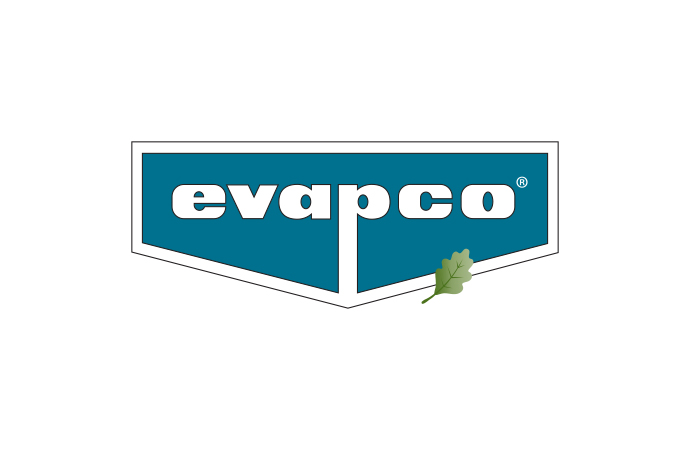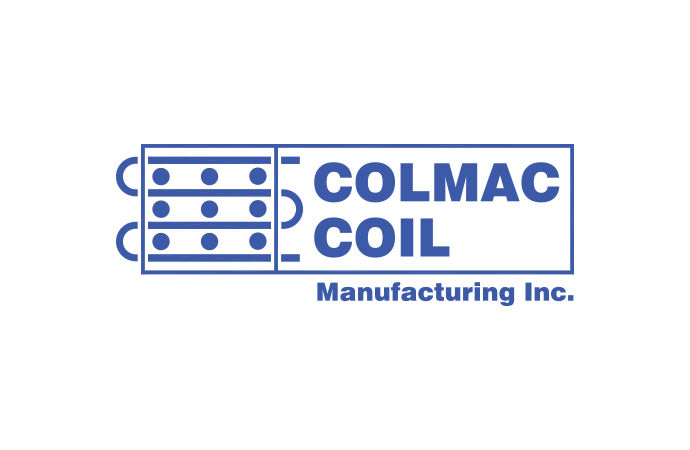At the IIAR Conference and Exhibition, the manifold industrial refrigeration components on display addressed low-charge, safety, efficiency, space saving and more.

It takes a lot of components to make an industrial refrigeration system, and they were all on offer at the 2016 International Institute of Ammonia Refrigeration (IIAR) Industrial Refrigeration Conference & Exhibition in Orlando, Florida, last month.
Everything from low-charge packages and DX evaporators to liquid separators and screw compressors could be found on the exhibition floor, home to dozens of component makers, OEMs, contractors and training companies.
Next step for Evapco
Evapco, based in Taneytown, Maryland, is “shifting into second gear” in its marketing of Evapcold, a line of self-contained low-charge ammonia refrigeration units, said Kurt Liebendorfer, Evapco’s vice-president. Evapcold is being installed at Western Gateway Storage in Ogden, Utah.
Liebendorfer explained that new buildings (greenfield projects), which account for about half of the market for Evapcold units, “have long funding, design and development phases,” up to a year, “and we're progressing there.” He also expects Evapcold to be adopted in expansions of existing buildings. “We’ll have more announcements this year,” he said.
The Evapcold unit incorporates all parts of a refrigeration unit, including the evaporator. It employs a pumped recirculation system, but reduces the ammonia charge via smaller, enhanced evaporator tubes (five eighths of an inch in diameter) with a recirculation rate of 1.2-1. Evapco plans to introduce a DX packaged system for higher temperature applications later this year.
Colmac Coil, Colville, Wash., has been gaining considerable interest in its Advanced DX low-charge ammonia evaporator, used for low temperatures in concert with a central machine room. Developed by Bruce Nelson, president of Colmac, the DX evaporator cuts the charge by a factor of 4-5 times compared with a conventional pumped ammonia system. Colmac has recently released case studies on several installations of its Advanced DX system at US cold storage warehouses, including facilities operated by Preferred Freezer Services in Richland, Wash.; Shepherd’s Processed Eggs, Spanish Fork, Utah; Joliet Cold Storage, Joliet, Illinois; and US Cold Storage, Laredo, Texas.
At the IIAR Conference, Colmac showcased a “low profile” evaporator for industrial applications designed for “smaller processing rooms,” said Scott McMillan, CEO of Colmac Coil. The company also featured EC fans with built-in variable-speed control and a liquid air cooler for conveying glycol more efficiently in a low-charge ammonia system using secondary glycol cooling.
The liquid air cooler has an enhanced tube design that “changes the flow pattern of glycol inside the tube,” said McMillan. This reduces the pumping power required as well as improving the heat transfer of the glycol. “It’s another twist to low-charge design,” he added.
Energy-saving separator
At the Alfa Laval booth, the company featured its U-Turn liquid separator, designed to work with plate heat exchangers in ammonia applications. It has been used, for example, by the city of Montreal over the past year in municipal ice rinks. It is also used in the food industry.
The u-shaped separator is placed on top of the Alfa Laval M10 semi-welded gasketed heat exchanger in an evaporator, and the Alfa Laval AlfaNova 400 in a condenser. The combination saves space, reduces ammonia charge and maximises efficiency.
“The U-Turn is starting to be well-known in the market,” said Jesper Olsen, business and application manager for Alfa Laval, based in Lund, Sweden.
Because of its proximity to the evaporator or condenser, the U-Turn liquid separator reduces the pressure inside the heat exchanger and thus the energy expended by the compressor up to 4%, cutting costs, explained Olsen.
Danfoss, Baltimore, Md., displayed a larger version of its ICF Flexline valve station for evaporators in cold storage or food processing plants. The modular unit is designed to improve the safety of an ammonia system. “It is a direct-weld solution, with no gaskets, making it easier to service,” said Jim Hower, industrial refrigeration national sales manager for Danfoss.
The new model can accommodate up to 30 tons of capacity in low-temperature applications and 60 tons in medium temperatures.
Parker Hannifin, Broadview, Ill., showcased a new stainless steel electronic valve for ammonia liquid feed and CO2 (for which it is rated 52 bar). It also displayed a capacitive-based back-up module that, in the event of power loss, “fails closed or to a known position,” said Andy Kuester, division marketing manager for Parker. “It’s better than a battery back-up because batteries degrade.”
Parker also highlighted a rapid purger V300 machine, which removes unwanted non-condensable gases; in its latest iteration, the machine tracks the amount of ammonia loss over time.
Bitzer U.S., Flowery Branch, Georgia, highlighted its multiple screw compressor configuration for industrial applications in the range of 100-300 TR. Used in low-charge chillers, the compressors offer higher efficiency and redundancy compared with a single compressor with triple the horsepower. When load requirements drop, one or two of the compressors can be shut down, as compared to using a slide valve in a single compressor, which is less efficient.
The Garden City Ammonia Program (GCAP), a major training organisation based in Garden City, Kan., will be re-launching the Spanish language version of its ammonia operator one class, said Miguel Bermudez, who will be teaching it.
Interest in the class has been coming from Latin and South America, as well as in the US. “There’s a huge need for it,” said Bermudez. “It’s an untapped market.”
This article is authored by Michael Garry. The full version first appeared in the April 2016 edition of Accelerate America.
Everything from low-charge packages and DX evaporators to liquid separators and screw compressors could be found on the exhibition floor, home to dozens of component makers, OEMs, contractors and training companies.
Next step for Evapco
Evapco, based in Taneytown, Maryland, is “shifting into second gear” in its marketing of Evapcold, a line of self-contained low-charge ammonia refrigeration units, said Kurt Liebendorfer, Evapco’s vice-president. Evapcold is being installed at Western Gateway Storage in Ogden, Utah.
Liebendorfer explained that new buildings (greenfield projects), which account for about half of the market for Evapcold units, “have long funding, design and development phases,” up to a year, “and we're progressing there.” He also expects Evapcold to be adopted in expansions of existing buildings. “We’ll have more announcements this year,” he said.
The Evapcold unit incorporates all parts of a refrigeration unit, including the evaporator. It employs a pumped recirculation system, but reduces the ammonia charge via smaller, enhanced evaporator tubes (five eighths of an inch in diameter) with a recirculation rate of 1.2-1. Evapco plans to introduce a DX packaged system for higher temperature applications later this year.
Colmac Coil, Colville, Wash., has been gaining considerable interest in its Advanced DX low-charge ammonia evaporator, used for low temperatures in concert with a central machine room. Developed by Bruce Nelson, president of Colmac, the DX evaporator cuts the charge by a factor of 4-5 times compared with a conventional pumped ammonia system. Colmac has recently released case studies on several installations of its Advanced DX system at US cold storage warehouses, including facilities operated by Preferred Freezer Services in Richland, Wash.; Shepherd’s Processed Eggs, Spanish Fork, Utah; Joliet Cold Storage, Joliet, Illinois; and US Cold Storage, Laredo, Texas.
At the IIAR Conference, Colmac showcased a “low profile” evaporator for industrial applications designed for “smaller processing rooms,” said Scott McMillan, CEO of Colmac Coil. The company also featured EC fans with built-in variable-speed control and a liquid air cooler for conveying glycol more efficiently in a low-charge ammonia system using secondary glycol cooling.
The liquid air cooler has an enhanced tube design that “changes the flow pattern of glycol inside the tube,” said McMillan. This reduces the pumping power required as well as improving the heat transfer of the glycol. “It’s another twist to low-charge design,” he added.
Energy-saving separator
At the Alfa Laval booth, the company featured its U-Turn liquid separator, designed to work with plate heat exchangers in ammonia applications. It has been used, for example, by the city of Montreal over the past year in municipal ice rinks. It is also used in the food industry.
The u-shaped separator is placed on top of the Alfa Laval M10 semi-welded gasketed heat exchanger in an evaporator, and the Alfa Laval AlfaNova 400 in a condenser. The combination saves space, reduces ammonia charge and maximises efficiency.
“The U-Turn is starting to be well-known in the market,” said Jesper Olsen, business and application manager for Alfa Laval, based in Lund, Sweden.
Because of its proximity to the evaporator or condenser, the U-Turn liquid separator reduces the pressure inside the heat exchanger and thus the energy expended by the compressor up to 4%, cutting costs, explained Olsen.
Danfoss, Baltimore, Md., displayed a larger version of its ICF Flexline valve station for evaporators in cold storage or food processing plants. The modular unit is designed to improve the safety of an ammonia system. “It is a direct-weld solution, with no gaskets, making it easier to service,” said Jim Hower, industrial refrigeration national sales manager for Danfoss.
The new model can accommodate up to 30 tons of capacity in low-temperature applications and 60 tons in medium temperatures.
Parker Hannifin, Broadview, Ill., showcased a new stainless steel electronic valve for ammonia liquid feed and CO2 (for which it is rated 52 bar). It also displayed a capacitive-based back-up module that, in the event of power loss, “fails closed or to a known position,” said Andy Kuester, division marketing manager for Parker. “It’s better than a battery back-up because batteries degrade.”
Parker also highlighted a rapid purger V300 machine, which removes unwanted non-condensable gases; in its latest iteration, the machine tracks the amount of ammonia loss over time.
Bitzer U.S., Flowery Branch, Georgia, highlighted its multiple screw compressor configuration for industrial applications in the range of 100-300 TR. Used in low-charge chillers, the compressors offer higher efficiency and redundancy compared with a single compressor with triple the horsepower. When load requirements drop, one or two of the compressors can be shut down, as compared to using a slide valve in a single compressor, which is less efficient.
The Garden City Ammonia Program (GCAP), a major training organisation based in Garden City, Kan., will be re-launching the Spanish language version of its ammonia operator one class, said Miguel Bermudez, who will be teaching it.
Interest in the class has been coming from Latin and South America, as well as in the US. “There’s a huge need for it,” said Bermudez. “It’s an untapped market.”
This article is authored by Michael Garry. The full version first appeared in the April 2016 edition of Accelerate America.
Related stories









